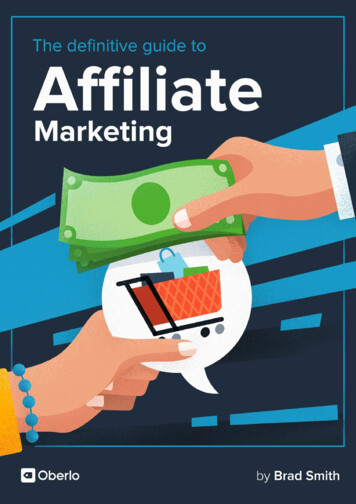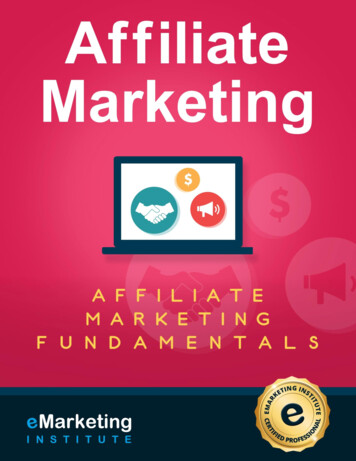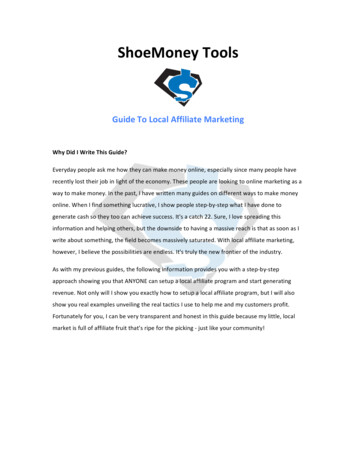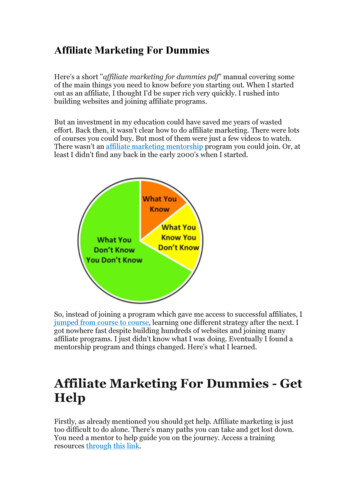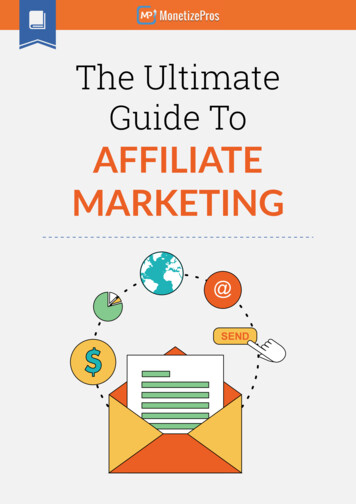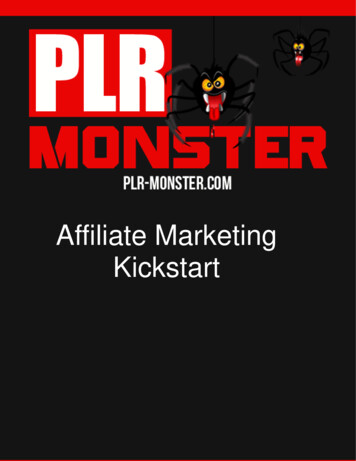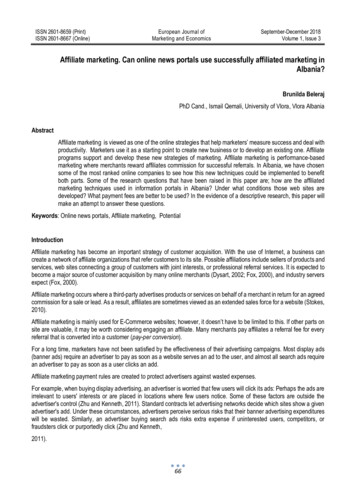
Transcription
ISSN 2601-8659 (Print)ISSN 2601-8667 (Online)European Journal ofMarketing and EconomicsSeptember-December 2018Volume 1, Issue 3Affiliate marketing. Can online news portals use successfully affiliated marketing inAlbania?Brunilda BelerajPhD Cand., Ismail Qemali, University of Vlora, Vlora AlbaniaAbstractAffiliate marketing is viewed as one of the online strategies that help marketers’ measure success and deal withproductivity. Marketers use it as a starting point to create new business or to develop an existing one. Affiliateprograms support and develop these new strategies of marketing. Affiliate marketing is performance-basedmarketing where merchants reward affiliates commission for successful referrals. In Albania, we have chosensome of the most ranked online companies to see how this new techniques could be implemented to benefitboth parts. Some of the research questions that have been raised in this paper are; how are the affiliatedmarketing techniques used in information portals in Albania? Under what conditions those web sites aredeveloped? What payment fees are better to be used? In the evidence of a descriptive research, this paper willmake an attempt to answer these questions.Keywords: Online news portals, Affiliate marketing, PotentialIntroductionAffiliate marketing has become an important strategy of customer acquisition. With the use of Internet, a business cancreate a network of affiliate organizations that refer customers to its site. Possible affiliations include sellers of products andservices, web sites connecting a group of customers with joint interests, or professional referral services. It is expected tobecome a major source of customer acquisition by many online merchants (Dysart, 2002; Fox, 2000), and industry serversexpect (Fox, 2000).Affiliate marketing occurs where a third-party advertises products or services on behalf of a merchant in return for an agreedcommission for a sale or lead. As a result, affiliates are sometimes viewed as an extended sales force for a website (Stokes,2010).Affiliate marketing is mainly used for E-Commerce websites; however, it doesn’t have to be limited to this. If other parts onsite are valuable, it may be worth considering engaging an affiliate. Many merchants pay affiliates a referral fee for everyreferral that is converted into a customer (pay-per conversion).For a long time, marketers have not been satisfied by the effectiveness of their advertising campaigns. Most display ads(banner ads) require an advertiser to pay as soon as a website serves an ad to the user, and almost all search ads requirean advertiser to pay as soon as a user clicks an add.Affiliate marketing payment rules are created to protect advertisers against wasted expenses.For example, when buying display advertising, an advertiser is worried that few users will click its ads: Perhaps the ads areirrelevant to users' interests or are placed in locations where few users notice. Some of these factors are outside theadvertiser's control (Zhu and Kenneth, 2011). Standard contracts let advertising networks decide which sites show a givenadvertiser's add. Under these circumstances, advertisers perceive serious risks that their banner advertising expenditureswill be wasted. Similarly, an advertiser buying search ads risks extra expense if uninterested users, competitors, orfraudsters click or purportedly click (Zhu and Kenneth,2011).66
ISSN 2601-8659 (Print)ISSN 2601-8667 (Online)European Journal ofMarketing and EconomicsSeptember-December 2018Volume 1, Issue 3One interesting characteristic of affiliate marketing is that there are no up-front costs to either the host or the sponsor (Zeffand Aronson 1997). The sponsor, however, faces some hidden costs of entering into an affiliate relationship with too manypartners.The ideal host site for an affiliate sponsor would be one that attracts the same, or similar, customers that is interested. Thisin turn implies that the host should be the one that retails products and shares similarities with the products sold by theaffiliate sponsor. The problem then is identifying the relationships among the different product categories.This is similar to the category management problem faced by traditional retailers and extensivelyexplored in the retailing literature (Ludwig, 2012). In this case, the marketers' chief interest is studying demandsubstitutability (within product categories) and demand complementarily (across product categories) to guide decisions withrespect to merchandising, store layout decisions, and so forth (Russell and Kamakura, 1997).Literature review2.1 Online Advertising and Affiliate MarketingThe concept “online advertising” has many definitions. (Chaffey,2000) claims that advertising takes place when advertiserpays to place advertising content on another website. Internet advertising is a traffic building campaign – a method toincrease the audience of a website.Online advertising is a form of promotion that uses the Internet and World Wide Web (WWW) to deliver marketing messagesto attract customers.For content providers, online advertising is an important revenue stream. They can sell advertising space to the merchantsto promote their products and services (Chaffey, 2000).Content providers have four options to sell the advertising space: direct selling, site representation firm, ad network andauctions.Recently another option named affiliate marketing has been used effectively. Affiliate marketing is an agreement betweena merchant and content providers to promote merchants’ products or services on their websites.Merchants are called advertisers in online marketing and they pay for the content providers’ services only when visitor fromtheir website execute a specified action. Such action can be a purchase of a product for example, filling in a form withpersonal data, subscribing to a newsletter etc.2.2 Who are affiliates?Affiliates are specializing in different areas and offering different types of affiliate marketing on their websites. There aresome types of them:Type 1: Niche content and personal interest websitesAffiliates run websites that cater to a certain niche in the online marketplace and can be an ideal way for merchants totarget users specifically interested in certain products and drive great quality traffic. Websites that would fall into thiscategory include sites offering free bias, information on certain hobbies or topics, games and bingo websites, and retail andtravel-related sites.Type 2: Loyalty and reward websitesLoyalty and reward websites build a loyal user base by marketing merchants to their users and then share their profits withthem. They can share these profits by offering pure cash back to users or awarding them points that can be used tocontribute towards discounted online purchases through the website.Type 3: PPC and search affiliatesPay per click (PPC) and search affiliates bid on words and phrases in search engines to help drive traffic to a merchant’swebsite by using the sponsored links on portals such as Google, Yahoo, etc. Affiliates are now able to use brand terms and67
ISSN 2601-8659 (Print)ISSN 2601-8667 (Online)European Journal ofMarketing and EconomicsSeptember-December 2018Volume 1, Issue 3improve merchant rankings within the natural portal listings. This is called organic search engine optimization (SEO).Merchants are able to choose whether they wish their products to have affiliates bidding to promote them. If they do, theymust then decide whether affiliates may bid on brand terms or just generic terms. Brand term means using the actualmerchant name, whereas generic term refers to using a genre or topic to bid on the product.Type 4: Email marketersEmail affiliates send stand-alone email campaigns to their users. Companies have been set-up specializing in this form ofaffiliate marketing and have expansive and comprehensive lists which allow merchant’s to target specific niches within theirtarget market. Email marketers tend to be paid on a cost per thousand (CPM) bases.Type 5: Affiliate networksAffiliate networks are establishing themselves as ‘top tier’ affiliates exposing merchant offers to their own networks ofaffiliates while providing account management and assistance where needed. These large scale networks are often capableof providing email marketing, co-registration, PPC and classic affiliate banners, and skyscrapers to run on their affiliate’swebsites.Type 6: Co-registration affiliatesCo-registration is a fairly new form of affiliate marketing and allows users to choose offers from third-party merchants whilstregistering on a website, but only with the user’s full approval. Registration details are passed on to the merchant who thenpays the affiliate for the users details.2.3 Advantages and Disadvantages of Affiliate MarketingAffiliate marketing is beneficial both for merchants and affiliate marketers (Ludwig, 2012).Merchants can hire various independent websites to advertise their products and services. Advertiser of merchant can onlypay the content providers if the ad actually leads to a sale and advertising costs move from fixed to variable costs on ad inaffiliate marketing. It can facilitate allocating money to advertising.Even content providers can enjoy various advantages from affiliate marketing. It offers content providers new chances togenerate revenues from their websites offering them the opportunity to cooperate with large number of merchants, whichthey would not have access otherwise (Russell and Wagner, 1997).Some disadvantages are observed in affiliate marketing. Accounts of false and misleading types of advertising that lead tounjust claim and also complaints people. The shady and illegal practices involved in this kind of business include falseadvertising, unlawful use of trade names, logos, or other branding, spamming and hijacking. Merchants sometimesintentionally close down programs without informing the affiliates and paying commissions.Sometimes affiliates engage in false advertising and misleading the customer in order to get commission. This means thatsome affiliates sometimes make claims and promises regarding the product and services which are completely wrong orthey extremely exaggerate it. When this happens, the merchant usually suffers complaints and they definitely lose potentialcustomer.As affiliate ads pay out on results, content providers do not have any guarantees that they will make money. They mayhave to try a number of different affiliates to find those that their visitors respond to. Content providers should have a goodidea of the profile of people that visit their site to ensure their target customers appropriately. The time from placing the adup to getting payment can be several months depending on the affiliate schemes or network content provider register with.2.4 Affiliate marketing pricing modeThe following, are the main types of affiliate marketing models (Affiliatefix, 2014):CPM or cost-per-thousand impressions, is one of the oldest metrics for affiliate marketing. Merchants will pay publishers afixed rate for every thousand impressions their advertisement is served. Targeted traffic is regarded better.68
ISSN 2601-8659 (Print)ISSN 2601-8667 (Online)European Journal ofMarketing and EconomicsSeptember-December 2018Volume 1, Issue 3CPC or cost-per-click marketing is one of the moods where publishers charge a fee for an individual click delivered to themerchant’s site or program. Costs will vary per click and will be significant to the competition within the sector or niche.CPL or cost-per-lead is used in sectors where the customers’ acquisition isn’t always completed in a single online session.It can vary from gathering something as simple as an email address to a large form or action. Leads are priced accordingto the corresponding criteria.CPD or cost-per-download is the process of the merchant paying when downloading or installing. Otherwise known as costper-install, the CPD model has seen a significant increase with the rise of mobile advertising and apps.CPC or cost-per-call, also known as pay-per-call, is the pricing model where by merchant will pay on a call-in basis.Publishers will get customers to qualify a purchase or transaction by calling a specific number.CPA or cost-per-action is the most popular model for direct response marketers. Merchants are almost guaranteed profitas they only pay per action, which is set out in the initial stages. The payout differs on the level of action that is required,for example, an email submission will pay less than a full form submission.Tenancy pricing model is where the merchant or advertiser pays a flat, fixed fee per month regardless of the amount ofimpressions, clicks or leads. Although the results can be hard to measure, and there’s no guarantee it will work, the tenancymodel can offer large coverage for big companies and brands.Hybrid pricing model is the combination of several of the above. It’s used when a merchant wants to track and focus on thewhole purchase or funnel of the offer. Offering different models across one process can really benefit publishers andmerchants.Revenue share is when the merchant agrees to share a commission or portion of the conversion with the publisher. It isoften used when a customer may be spending money on a product or program more than several times.Most affiliate marketing programs, will work on one or several of the above pricing models.2.5 TrafficInternet traffic is the flow of people and data across the internet. In order to get conversions or views on your affiliatemarketing campaigns, it is necessary to know how to gain traffic. The definition of traffic is basically the amount of viewerson your website.Internet traffic comes in many forms. However, it can often be separated into paid or free. Paid traffic is usually leveragingoff someone else and paying for it. Most of the time, paid traffic can be instant, though often you are put through an approvalprocess. For example, if someone were to buy some advertising space on a website, it would be classed as paid traffic. Inmany instances, a budget or funding is needed in order to get started with paid traffic, as sometimes you’re required to payprior to the traffic coming in. Any online platform or service that demands you pay prior to, or after, for website traffic, fallsunder the paid traffic category.For example Google ads, Facebook ads, any real time bidding or self-serve platform will all fall under paid traffic. The costand pricing model comes down to how targeted and volatile the specific niche of the traffic is. The more popular and targetedit is, the more you will be paying for the traffic, in most cases.Free TrafficThe opposite of paid traffic is free traffic. This is traffic that you don’t directly pay for to be sent to your site. Using a varietyof methods, free traffic can be sent to your website without a payment for it. Free traffic methods can take longer, especiallywith something like SEO (search engine optimization).Free traffic comes in many shapes and forms. However, the most popular methods are those of SEO and social marketing.For instance, if someone has a large Facebook Fan Page for his niche and direct users to the site via a status update, thatis free traffic you haven’t had to pay for. Another example would be if you were able to rank a keyword on the first page of69
ISSN 2601-8659 (Print)ISSN 2601-8667 (Online)European Journal ofMarketing and EconomicsSeptember-December 2018Volume 1, Issue 3Google for your site and you didn’t pay for any ranking. The traffic you would be receiving from Google would be free traffic.Obviously, if you have a budget, paid traffic is a faster way? But, if your budget it limited then free traffic is yourchoice. Longevity, on the one hand, can be achieved from free traffic. On the other hand, paid traffic is often used for ashort burst, making it successful for specific campaigns (Neeman, 2013).When learning affiliate marketing, it is easy to get lost in multiple traffic sources. The key is to pick one or two and masterthem. Most new affiliate marketers will start on free traffic since funds are low and it is a great way to learn the basic. Thenthey decide to move into paid traffic when they have a larger budget, giving them the option to test different sources.2.6 Important Choices for affiliate marketingAccording to (Affiliatefix.com, 2017) an affiliate should take into consideration:Gender breakdown:This split is pretty even and in line with the general population which is; 51% male and 49% female.Age breakdown:Affiliate marketing is certainly something anyone can do. The distribution of age is interesting and encouraging to anyoneinterested in generating additional income from affiliate marketing efforts.Income for ages are; Age 22-25: 2.5%, Age 26-30: 22%, Age 31-40: 19%, Age 61 : 9%.Work location:Many affiliates enjoy the flexibility of working at home and balancing maximum efficiency and comfort; while others stillcommute to the office or split their time between both. Affiliate that work from home: 59%, Commute to office: 18% andBoth: 23%.Traffic generation:Every affiliate has its secrets to generate traffic to the websites; this is what makes them unique. While these methods don'tvary too much; thus, providing insight into what traffic channels are working, where the volumes at and what's profitable forothers. Affiliates love free traffic, which is obvious with SEO, Social, Blogging and Word of Mouth, all top the charts.Traffic generation from:Search Engine Optimization: 79%,Social Networks: 60%, Blogging: 59%, Word of Mouth: 37%, Email Marketing: 28%, PayPer Click: 27%, Video or Images: 21%, Display Advertising: 19%, Offline Marketing: 16%, Comment Marketing: 12%, GuestPosting: 11%, Other: 5%.Product promotion:While retail and consumer products and services are certainly the lion's share of the offers out there, you can't forget aboutbusiness products. What's interesting is how few affiliates solely dedicate their efforts towards driving business-to-businessproducts.Product promotion goes:B2C: 69%, B2B: 1.3%, Both: 29.7%.Contact method:Affiliates almost unanimously prefer to be contacted via email. While some networks and relationships may supportmethods of contact outside email, it's very uncommon. Contacts Methods are; Email: 91%, IM: 4%, Phone: 8%, All of theabove: 7%, Other: 1%.70
ISSN 2601-8659 (Print)ISSN 2601-8667 (Online)European Journal ofMarketing and EconomicsSeptember-December 2018Volume 1, Issue 3Selecting merchants:When affiliates were asked what their top 3 factors (Affiliatefix.com, 2017) are when selecting what merchant to promote,commission remains on top, more so than the relevancy of the product or service. What is really interesting is that affiliatenetwork/tracking platform was the 3rd more important factor. When merchants are looking to launch their affiliate program,keeping that in mind can do wonders for affiliate recruitment. Commission 62%, product or service relevancy: 54.4%,affiliate network or tracking platform: 36.7%, brand awareness: 34.2%, merchant reputation: 31%, cookie duration: 24.1%,affiliate program reputation: 24.1%, payment terms and methods: 17.1%, terms and conditions: 16.5%, earnings per click:15.2%, other: 9.5%, ads and landing pages: 7%.Finding programs:Affiliates are constantly seeking out new affiliate programs to join, especially as their traffic increases or diversify. Although,affiliates are most likely to reach out and request joining an affiliate program, most likely through a network, advertisersshould know that them reaching out to the affiliate is still a common practice. Affiliates also use search engines to findaffiliate programs. As an advertiser, having a Pay per Click strategy in place to include affiliate program related keywordscan help increase your affiliate base. Affiliate info on merchant's website: 51%, affiliate Manager reaches out directly: 42%,search engine searches: 39%, affiliate or CPA network: 38%, check competitor's websites: 26%, word of mouth: 20%,affiliate manager website: 15%, conferences: 9%, other: 8%, print publications: 4%.Program promotion:Most affiliates are specialists in their niche, which means they generally only promote closely related products andadvertisers (Affiliatefix.com ,2017 ). Almost half of affiliates this last year were promoting 10 or fewer programs. Over 75%promote fewer than 50 affiliate programs, 1 - 10: 47%, 11 - 20: 16%, 21 - 50: 14%, 51 - 100: 6%, 101 - 200: 3%, 201 - 300:1%, 300 : 12%.Network affiliation:To join a network, merchants are usually charged to launch or to set it up. For affiliates though, it is almost always free tojoin(Affiliatefix.com, 2017). This enables them to belong to several networks, in some cases, every network. A good networkwill have high quality merchants, reliable tracking, affiliate-friendly tools and sophisticated reporting, among other things.Ranking of network affiliation are; ShareASale: 83.7%, Commission Junction: 77.8%, LinkShare: 58.2%, LinkConnector:43.1%, ClickBank: 41.2%, PepperJam: 35.3%, AvantLink: 21.6%, Impact Radius: 17%, Affiliate Window: 15.7%, DigitalRiver: 13.7%.MethodologyFor affiliates, keeping up to date with merchants, other affiliates and the industry is probably the key to growth (Stokes,2010). Joining forums and keeping tabs on industry leaders will help do just that. So the information from forums andwebsites is relevant. We used forums, web sites, academic journals and books to gain secondary data for the researchpurpose.Primary data. As traffic is one of the evidence of successful affiliate marketing, we first found evidence of the most rankedsites in Albania. Statistics were used from alexia.com part of amazon.com, as one of the most successful affiliates site(Ranking.com, 2017). Ranking (the number of sites linking in Alexa reports is the number of websites in Alexa’s crawl ofthe web that link to a given website) is a rough estimate of this site's popularity.The rank is calculated using a combination of average daily visitors to this site and its page views over the past 3 months.The site with the highest combination of visitors and page views is ranked #1. (Aleksa.com). We chose 30 of the firstwebsites. From them we selected only Albanian online journals or news portals (not Kosovo s site).We used observation technique as an instrument of collecting data. (Marshall and Rossman 1989), define observation as“the systematic description of events, behaviors, and artifacts in the social setting chosen for study" in qualitative research.71
ISSN 2601-8659 (Print)ISSN 2601-8667 (Online)European Journal ofMarketing and EconomicsSeptember-December 2018Volume 1, Issue 3For a Period of Two weeks we observed the pages of the websites selected. We found the companies ads on their websites. We grouped them in two categories: affiliate and on line ads. Then for each of them we used the consumer ghosttechnique to gather information from their websites as price per ads (do they use affiliate programs etc.).Research Question1. How are affiliated marketing techniques used in information portals in Albania?2. Under what condition the new portal webs are developed?3. What payment technique is better to use?4. Should there be used an affiliated program or can these portals be affiliated on their own?I. FindingsThe emerging world of blogs must be understood within the larger context of a changing global news arena where thepublic naturally seeks perspectives beyond one specific locality and nation (Croad, 2003). The migration of news andinformation to an online platform has disrupted old patterns of reading and changing the relationship between audiencesand news providers.As traffic is one of the evidence of successful affiliate marketing, we first found evidence of the most ranked sites in Albania.We used alexia.com part of amazon.com as one of the most successful affiliate sites. Ranking (the number of sites linkingin Alexa reports is the number of websites in Alexa’s crawl of the web that link to a given website) is a rough estimate ofthis site's popularity. In the thirty first sites ranked, we found five Albanian Information Portals or online newspapers. Theother sites were web portal from Kosovo (5), international websites as face book, youtube etc( 5), and the other wereentertainment pages. The results and its respective ranking is as follow for the News Portal:Web 924Table nr.1 The ranking of websitesThe new e-paper technology has provided the newspaper companies with the possibility of publishing a portable digital enewspaper with the same readability as in print media. The e-newspaper is converging print and online with the best fromtwo worlds, i.e. the overview and familiar design of the printed edition and the interactivity and continuous updates of theweb. An online newspaper is created by the convergence of the newspaper and the Internet. As Chyi and Sylvie (2001)describe “technologically, the Internet enables online newspapers to seek a world-wide market. Most online newspapersare owned by their print counterparts, also serve as online editions’ primary content providers”. According to (Boczkowski,2004) the emergence of online newspapers has occurred “partly as a reaction to major socioeconomic and technologicaltrends, such as changing competitive scenario and developments in computers and telecommunications – trends that, inturn, online newspapers have influenced”.Table 1 shows a high ranking of these portals. Thus, the first condition for successful affiliate marketing from these portalsis evident. These portals may serve as affiliates, bringing benefits for merchant and portals to. Ranking is an importantevidence, but is not enough. We need to see other element of these portals.Web site/publisherNr. of addsNr. of affiliate addsBalkanweb.com12172
ISSN 2601-8659 (Print)ISSN 2601-8667 (Online)European Journal ofMarketing and lionline.com122Gazetatema.al100September-December 2018Volume 1, Issue 3Table nr 2. Ads for the websitesAs we mentioned above ads and affiliate marketing are close to each other. They differ in the payment fee. From theobservation process we noted that these portal use affiliate marketing in a restricted way. The merchant are internationaland they belong to the trade of clothes and to the industry of download programs. Than we made a web analyses of themerchant that actually use this portals. Some of them can be affiliate one. For an average of 12.35 daily pages view,affiliate ads of Balkanweb.com, can be adopted to the content of each page. While “Shekulli on line” can use the highestdaily time on site and a high daily pages view. All sites have a high number of links that bring visitors to their sites. That isanother advantage that this web can use to attract sellers to their sites. “Shqiptrja.com” has an advantage in the number oflinks.Table nr. 3 shows the industry that actually use these portals to advertise their activities.Web tarja.comGazetatema.alPanorama.com.alDaily time on site(min)5.6521.529.449.578.01Percentage of albanian visitors60%47.60%75.50%55%62,9%Daily 5Table nr.3 Important statisticsWeb site/publisher1 Keywords %2 Keywords in %3 Keywords in com.al50%50%0%Table nr.4 KeywordsHow to maximize the keyword activity?Most customers have a feel for where they want to go online, and typically perform multiple searches, but research by(Onestat, 2017) also shows the importance of covering generic long tail keywords: 2 word queries currently account for 30% of Searchqueries 3 words: 27% 4 words: 17.1% 5 words: 8.25% 6 words: 3.7%The use of Keywords is not optimal. Most webs use two keywords. This will affect the web search engine.Using at list two words will increase the possibility of finding the right site. This is crucial for Panormal.com.al,Shekullioniline.com and Telegrafi.com.73
ISSN 2601-8659 (Print)ISSN 2601-8667 (Online)European Journal ofMarketing and EconomicsSeptember-December 2018Volume 1, Issue 3Keywords will increase the possibility of finding the right site.Average prices of ads.Using the concept “Customer ghost”, entire representative portal webs above were contacted, as e representative of aconstruction company in Vlora. We asked them for the prices of their ads. The average prices listed above. We use theaverage price for two reasons:Little difference between prices is noted in different online portals.2. For ethical issues. As we used the costumer ghosts, we decided not to mention prices of ads for this portals;1.0PTION 1 (Width: 980px and Height: 100px) 120,000 lek2.0PTION 2 (Width: 140px and Height: 1500px) 110,000 lek3 .0PTION 3 Width: 140px and Height: 1500pX 110,000 lek4.0PTION 4 (Width: 9Opx and Height: 8Opx, only image) 30,000 lek5.0PTION 5 (Width: 222px and Height: 8Opx, only image) 45,000 lek6.0PTION 6 (Width: 9Opx and Height: 8Opx, only image) 30,000 lek7.0PTION 7 (Width: 30Opx and Height: 250px) 100,000 lek8.0PTION 8 (Width: 30Opx and Height: 250px) 90,000 lek9.0PTION 9 (Width: 30Opx and Height: 250px) 80,000 lek10.0PTION 10 (Width: 30Opx and Height: 250px) 70,000 lek11.0PTION 11(Width: 48Opx and Height: 90px) 55,000 lek12.0PTION 12 (Width: 48Opx and Height: 90px) 50,000 lek13.0PTION 13-16 (Width: 135px and Height: 300px) 60,000 lek17.0PTION 17 (Width: 970px and Height: 50px) 90,000 lekThese were the average fees for the month.Since March 22, 2011, a feature has been added into the Adsense Reporting system, where we can see the ad performancebased on countries. This is the raking that compile with around 10 million ad impressions from 10 sites of di
Affiliate marketing is viewed as one of the online strategies that help marketers’ measure success and deal with productivity. Marketers use it as a starting point to create new business or to develop an existing one. Affiliate programs support and develop these new strategies of marketing.
